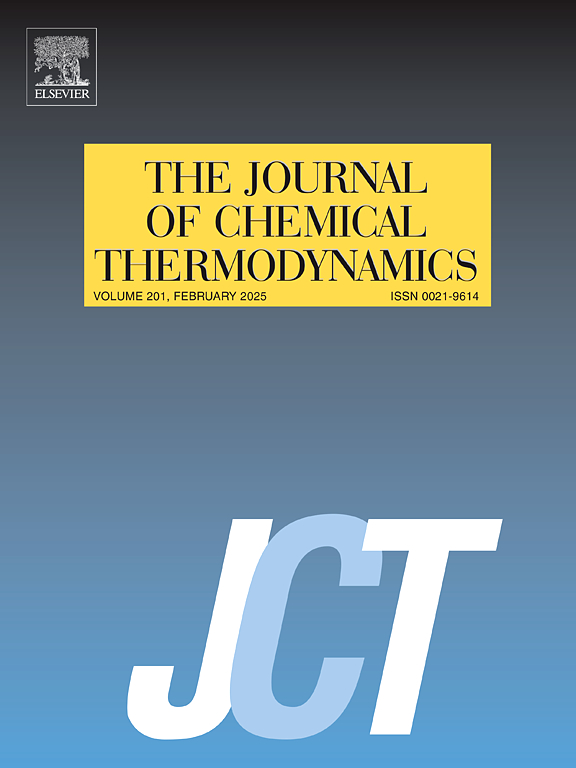Extractive distillation separation of isopropanol - isopropyl acetate azeotrope: Vapor-liquid equilibrium measurement and process optimization
IF 2.2
3区 工程技术
Q3 CHEMISTRY, PHYSICAL
引用次数: 0
Abstract
In industrial production, isopropanol (IPA) and isopropyl acetate (IPAC) serve as raw materials and products for each other. Due to the inability to achieve a 100 % conversion rate of the products, they usually exist as a mixture. However, IPA and IPAC can form a binary azeotropic mixture, making it difficult to separate them through conventional separation methods. In the current work, extractive distillation is being considered for the separation of IPA and IPAC using entrainers such as 4-methyl-2-pentanone (MIBK), chlorobenzene and butyl acetate. The vapor-liquid equilibrium (VLE) data of the binary systems (IPAC + MIBK / chlorobenzene / butyl acetate) at 101.3 kPa were determined, and the results passed the thermodynamic consistency tests (van Ness and pure component). Using three commonly used activity coefficient models (NRTL, UNIQUAC and Wilson) to correlate and regress the data, the results indicate that the vapor phase and temperature deviations are respectively less than 0.0037 and 0.1847 K. Afterwards, suitable entrainer was screened using the binary interaction parameters of regression, and an extractive distillation (ED) process was designed. The products purity reached 99.6 wt%, and the parameters were optimized with the goal of minimizing the bottom heat duty.

萃取精馏分离异丙醇-醋酸异丙酯共沸物:气液平衡测定及工艺优化
在工业生产中,异丙醇(IPA)和醋酸异丙酯(IPAC)互为原料和产品。由于无法达到100%的产品转化率,它们通常以混合物的形式存在。然而,IPA和IPAC可以形成二元共沸混合物,使其难以通过常规分离方法分离。在目前的工作中,正在考虑使用4-甲基-2-戊酮(MIBK)、氯苯和乙酸丁酯等夹带剂进行萃取精馏分离IPA和IPAC。测定了IPAC + MIBK /氯苯/乙酸丁酯二元体系在101.3 kPa下的气液平衡(VLE)数据,并通过了van Ness和纯组分的热力学一致性测试。利用NRTL、UNIQUAC和Wilson三种常用活度系数模型对数据进行相关和回归,结果表明,气相和温度偏差分别小于0.0037和0.1847 K。利用二元相互作用参数回归筛选了合适的夹带剂,并设计了萃取精馏工艺。产品纯度达到99.6 wt%,并以降低底热负荷为目标对工艺参数进行了优化。
本文章由计算机程序翻译,如有差异,请以英文原文为准。
求助全文
约1分钟内获得全文
求助全文
来源期刊

Journal of Chemical Thermodynamics
工程技术-热力学
CiteScore
5.60
自引率
15.40%
发文量
199
审稿时长
79 days
期刊介绍:
The Journal of Chemical Thermodynamics exists primarily for dissemination of significant new knowledge in experimental equilibrium thermodynamics and transport properties of chemical systems. The defining attributes of The Journal are the quality and relevance of the papers published.
The Journal publishes work relating to gases, liquids, solids, polymers, mixtures, solutions and interfaces. Studies on systems with variability, such as biological or bio-based materials, gas hydrates, among others, will also be considered provided these are well characterized and reproducible where possible. Experimental methods should be described in sufficient detail to allow critical assessment of the accuracy claimed.
Authors are encouraged to provide physical or chemical interpretations of the results. Articles can contain modelling sections providing representations of data or molecular insights into the properties or transformations studied. Theoretical papers on chemical thermodynamics using molecular theory or modelling are also considered.
The Journal welcomes review articles in the field of chemical thermodynamics but prospective authors should first consult one of the Editors concerning the suitability of the proposed review.
Contributions of a routine nature or reporting on uncharacterised materials are not accepted.
 求助内容:
求助内容: 应助结果提醒方式:
应助结果提醒方式:


